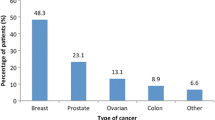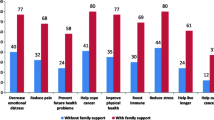Abstract
Purpose
We surveyed prostate cancer patients about complementary and alternative medicine (CAM) use and evaluated patient factors that correlated with CAM use 6 months following diagnosis.
Methods
The Prostate CAncer Therapy Selection study was a prospective, observational multi-site study of men’s treatment decision-making process after a diagnosis of local stage prostate cancer. Recruitment occurred in community urology practices in Washington State, hospital-based urology clinics affiliated with the University of Southern California, and Kaiser Permanente in Northern California. Eligible study participants included men over age 21 diagnosed with local stage prostate cancer between May 1, 2005 and December 31, 2006.
Results
Fifty-two percent of survey respondents (379) reported using one or more types of CAM. Of the patients, 51% used one CAM method, 26% used two methods, and 23% used three or more methods. The most commonly reported category was mind–body therapies (65%). Only 43% of patients discussed their CAM use with a health professional; of those, 20% informed their primary care physician and 30% told the doctor managing their prostate cancer care. Less than half thought the CAM they used was “very helpful”, but a majority thought it was somewhat helpful for their condition.
Conclusions
Further research is needed to characterize the goals prostate cancer patients have for CAM, whether the treatments met those goals, and how this translates into the perceived helpfulness of these therapies. The implications of patients not discussing CAM use with health professionals at the time of prostate cancer treatment need further studies.
Similar content being viewed by others
References
Altekruse SF, Kosary CL, Krapcho M, Neyman N, Aminou R, Waldron W, Ruhl J, Howlader N, Tatalovich Z et al (eds.) (2010) Seer cancer statistics review, 1975–2007, . National Cancer Institute. Available at: http://seer.cancer.gov/csr/1975_2007/, based on November 2009 SEER data submission, posted to the SEER web site, 2010. Accessed 17 Sept 2010
Zeliadt SB, Potosky AL, Etzioni R, Ramsey SD, Penson DF (2004) Racial disparity in primary and adjuvant treatment for nonmetastatic prostate cancer: SEER–Medicare trends 1991 to 1999. Urology 64(6):1171–1176
National Comprehensive Cancer Network (2009) Clinical practice guidelines in oncology, prostate cancer. Available at: http://www.nccn.org/professionals/physician_gls/PDF/prostate.pdf. Accessed 15 Mar 2009
Wilt TJ, MacDonald R, Rutks I, Shamliyan TA, Taylor BC, Kane RL (2008) Systematic review: comparative effectiveness and harms of treatments for clinically localized prostate cancer. Ann Intern Med 148(6):435–448
Thompson I, Thrasher JB, Aus G, Burnett AL, Canby-Hagino ED, Cookson MS, D’Amico AV, Dmochowski RR, Eton DT, Forman JD, Goldenberg SL, Hernandez J, Higano CS, Kraus SR, Moul JW, Tangen CM (2007) Guideline for the management of clinically localized prostate cancer: 2007 update. J Urol 177(6):2106–2131
Middleton RG, Thompson IM, Austenfeld MS, Cooner WH, Correa RJ, Gibbons RP, Miller HC, Oesterling JE, Resnick MI, Smalley SR et al (1995) Prostate cancer clinical guidelines panel summary report on the management of clinically localized prostate cancer. The American Urological Association. J Urol 154(6):2144–2148
Wasson JH, Cushman CC, Bruskewitz RC, Littenberg B, Mulley AG, Wennberg JE (1993) A structured literature review of treatment for localized prostate cancer. Prostate disease patient outcome research team. Arch Fam Med 2(5):487–493
Swarup AB, Barrett W, Jazieh AR (2006) The use of complementary and alternative medicine by cancer patients undergoing radiation therapy. Am J Clin Oncol 29(5):468–473
Evans M, Shaw A, Thompson EA, Falk S, Turton P, Thompson T, Sharp D (2007) Decisions to use complementary and alternative medicine (CAM) by male cancer patients: information-seeking roles and types of evidence used. BMC Complement Altern Med 7:25
Mansky PJ, Wallerstedt DB (2006) Complementary medicine in palliative care and cancer symptom management. Cancer J 12(5):425–431
National Center for Complementary and Alternative Medicine (2010) The use of complementary and alternative medicine in the united states. National Institutues of Public Health. Available at: http://nccam.nih.gov/news/camstats/2007/camsurvey_fs1.htm. Accessed 17 Sept 2010
Boon H, Brown JB, Gavin A, Westlake K (2003) Men with prostate cancer: making decisions about complementary/alternative medicine. Med Decis Mak 23(6):471–479
Lippert MC, McClain R, Boyd JC, Theodorescu D (1999) Alternative medicine use in patients with localized prostate carcinoma treated with curative intent. Cancer 86(12):2642–2648
Fasching PA, Thiel F, Nicolaisen-Murmann K, Rauh C, Engel J, Lux MP, Beckmann MW, Bani MR (2007) Association of complementary methods with quality of life and life satisfaction in patients with gynecologic and breast malignancies. Support Care Cancer 15(11):1277–1284
Molassiotis A, Fernandez-Ortega P, Pud D, Ozden G, Platin N, Hummerston S, Scott JA, Panteli V, Gudmundsdottir G, Selvekerova S, Patiraki E, Kearney N (2005) Complementary and alternative medicine use in colorectal cancer patients in seven european countries. Complement Ther Med 13(4):251–257
Habermann TM, Thompson CA, LaPlant BR, Bauer BA, Janney CA, Clark MM, Rummans TA, Maurer MJ, Sloan JA, Geyer SM, Cerhan JR (2009) Complementary and alternative medicine use among long-term lymphoma survivors: a pilot study. Am J Hematol 84(12):795–798
Zeliadt SB, Ramsey SD, Potosky AL, Arora NK, Oakley-Girvan I, Hamilton AS, Van Den Eeden SK, Penson DF (2008) Association of pre-existing symptoms with treatment decisions among newly diagnosed prostate cancer patients. The Patient 1(3):189–200
Ramsey SD, Zeliadt SB, Arora NK, Blough DK, Penson DF, Oakley-Girvan I, Hamilton AS, Van Den Eeden SK, Fedorenko CR, Potosky AL (2010) Unanticipated and underappreciated outcomes during management of local stage prostate cancer: a prospective survey. J Urol 184(1):120–125
Rose A, Peters N, Shea JA, Armstrong K (2004) Development and testing of the health care system distrust scale. J Gen Intern Med 19(1):57–63
Clark JA, Bokhour BG, Inui TS, Silliman RA, Talcott JA (2003) Measuring patients’ perceptions of the outcomes of treatment for early prostate cancer. Med Care 41(8):923–936
Roth AJ, Rosenfeld B, Kornblith AB, Gibson C, Scher HI, Curley-Smart T, Holland JC, Breitbart W (2003) The memorial anxiety scale for prostate cancer: validation of a new scale to measure anxiety in men with with prostate cancer. Cancer 97(11):2910–2918
Mehta SS, Lubeck DP, Pasta DJ, Litwin MS (2003) Fear of cancer recurrence in patients undergoing definitive treatment for prostate cancer: results from CAPSURE. J Urol 170(5):1931–1933
Arora NK, Weaver KE, Clayman ML, Oakley-Girvan I, Potosky AL (2009) Physicians’ decision-making style and psychosocial outcomes among cancer survivors. Patient Educ Couns 77(3):404–412
Wei JT, Dunn RL, Litwin MS, Sandler HM, Sanda MG (2000) Development and validation of the expanded prostate cancer index composite (epic) for comprehensive assessment of health-related quality of life in men with prostate cancer. Urology 56(6):899–905
National Cancer Institute (2008) Assessment of patients’ experience of cancer care (APECC) study survey instrument. Available at: http://outcomes.cancer.gov/surveys/apecc/download.html. Accessed 17 Sept 2010
Steenland K (2006) Personal communication of baseline and first follow-up questionnaires
National Institutes of Health. National Center for Complementary and Alternative Medicine (2009) What is CAM? NCCAM, National Institutes of Health. Available at: http://nccam.nih.gov/health/whatiscam/overview.htm. Accessed 2 Jul 2010
D’Amico AV, Hui-Chen M, Renshaw AA, Sussman B, Roehl KA, Catalona WJ (2006) Identifying men diagnosed with clinically localized prostate cancer who are at high risk for death from prostate cancer. J Urol 176(6 Pt 2):S11–S15
Tippens K, Marsman K, Zwickey H (2009) Is prayer CAM? J Altern Complement Med 15(4):435–438
Brown CM, Barner JC, Richards KM, Bohman TM (2007) Patterns of complementary and alternative medicine use in African Americans. J Altern Complement Med 13(7):751–758
Lee MM, Chang JS, Jacobs B, Wrensch MR (2002) Complementary and alternative medicine use among men with prostate cancer in 4 ethnic populations. Am J Public Health 92(10):1606–1609
Eng J, Ramsum D, Verhoef M, Guns E, Davison J, Gallagher R (2003) A population-based survey of complementary and alternative medicine use in men recently diagnosed with prostate cancer. Integr Cancer Ther 2(3):212–216
Jones RA, Taylor AG, Bourguignon C, Steeves R, Fraser G, Lippert M, Theodorescu D, Mathews H, Kilbridge KL (2007) Complementary and alternative medicine modality use and beliefs among African American prostate cancer survivors. Oncol Nurs Forum 34(2):359–364
Bausell RB, Lee WL, Berman BM (2001) Demographic and health-related correlates to visits to complementary and alternative medical providers. Med Care 39(2):190–196
Carpenter CL, Ganz PA, Bernstein L (2009) Complementary and alternative therapies among very long-term breast cancer survivors. Breast Cancer Res Treat 116(2):387–396
Diefenbach MA, Hamrick N, Uzzo R, Pollack A, Horwitz E, Greenberg R, Engstrom PF (2003) Clinical, demographic and psychosocial correlates of complementary and alternative medicine use by men diagnosed with localized prostate cancer. J Urol 170(1):166–169
Roberts CS, Baker F, Hann D, Runfola J, Witt C, McDonald J, Livingston ML, Ruiterman J, Ampela R, Kaw OC, Blanchard C (2005) Patient–physician communication regarding use of complementary therapies during cancer treatment. J Psychosoc Oncol 23(4):35–60
Wilkinson S, Farrelly S, Low J, Chakraborty A, Williams R (2008) The use of complementary therapy by men with prostate cancer in the UK. Eur J Cancer Care (Engl) 17(5):492–499
Acknowledgements
The participant recruitment and informed consent efforts in the Los Angeles area are due to the work of Ann S. Hamilton, PhD, at the Keck School of Medicine, University of Southern California (USC); David F. Penson, MD, MPH, formerly of the USC/Norris Comprehensive Cancer Center/USC (now at the Vanderbilt University Medical Center); L. Tracy Paz, MSN, RN, Charlotte Lee, MPH, MS, and Vicky Araujo at USC/Norris Comprehensive Cancer Center; and Norma Caldera, and Mary Lo at Los Angeles County/USC Medical Center. The Northern California recruitment was made possible by the efforts of Stephen K. Van Den Eeden, PhD, Amethyst Leimpeter, MS, and Brenna McGee at Kaiser Permanente in Northern California. The recruitment efforts in the Pacific Northwest region were made possible by independent urologists and their dedicated nursing staff in community clinics throughout Washington (Centralia, Edmonds, Everett, Olympia, Port Angeles, Tacoma, Silverdale, Spokane) and Portland, OR. Additionally, Ingrid Oakley-Girvan, PhD, MPH at the CPIC (formerly known as the NCCC), oversaw the data coordinating center for the collaborative study ensuring standardization and consistency in study methods and analyses across the three performance sites. The authors also wish to thank Arnold L. Potosky, PhD, (Lombardi Comprehensive Cancer Center, Georgetown University Medical Center) for his work on survey development.
Funding Source
This publication was supported by the National Cancer Institute contracts HHSN261200900582P, N01-PC-35142, N01-PC-35139, and N01-PC-35136.
This research was also supported by the Cancer Surveillance System of the Fred Hutchinson Cancer Research Center, which is funded by Contract No. N01-PC-35142 from the Surveillance, Epidemiology and End Results (SEER) Program of the National Cancer Institute with additional support from the Fred Hutchinson Cancer Research Center and the State of Washington.
The findings and conclusions in this report are those of the authors and do not represent any official position of the National Cancer Institute.
Conflict of Interest
The authors, with the exception of Neeraj Arora, report no financial relationships with the organization sponsoring this research which would indicate a conflict of interest. Neeraj Arora is an employee of the National Cancer Institute.
Author information
Authors and Affiliations
Corresponding author
Rights and permissions
About this article
Cite this article
McDermott, C.L., Blough, D.K., Fedorenko, C.R. et al. Complementary and alternative medicine use among newly diagnosed prostate cancer patients. Support Care Cancer 20, 65–73 (2012). https://doi.org/10.1007/s00520-010-1055-y
Received:
Accepted:
Published:
Issue Date:
DOI: https://doi.org/10.1007/s00520-010-1055-y




